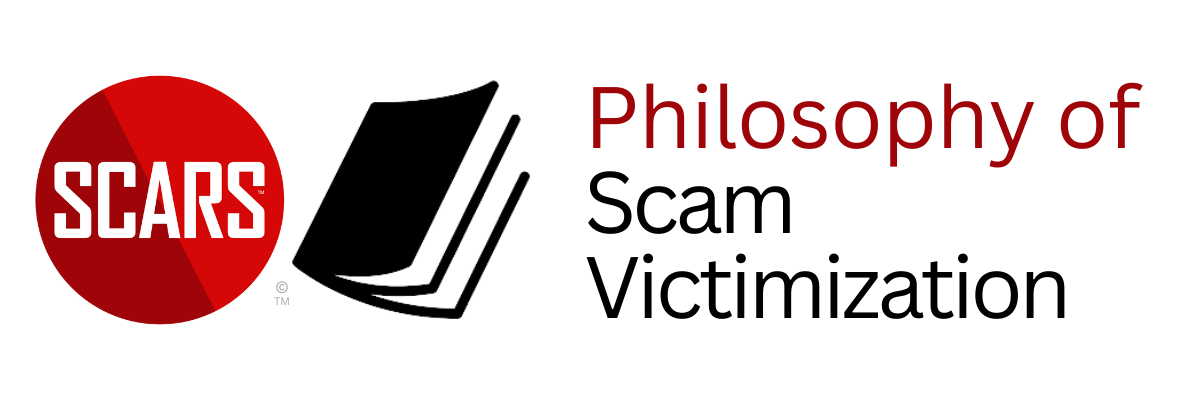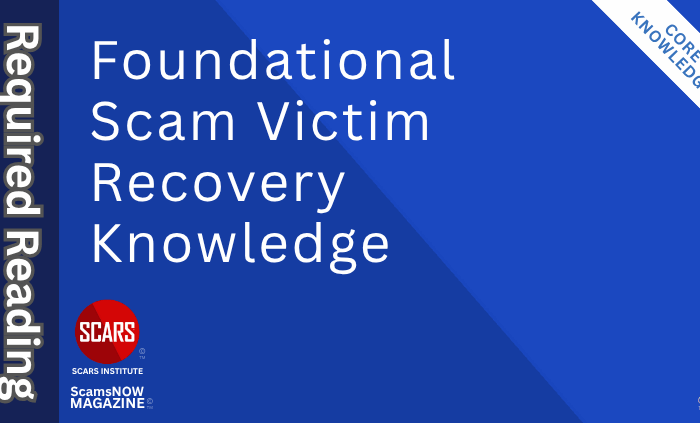SCARS Law™ – Murphy’s Law – and Other Rules About When Things Go Wrong!
If Something Can Go Wrong, It Will – Murphy’s Law, Murphy was an Optimist!
Primary Category: Philosophy of Scams
Intended Audience: Scam Victims-Survivors / Family & Friends / General Public / Others
Author:
• Tim McGuinness, Ph.D., DFin, MCPO, MAnth – Anthropologist, Scientist, Polymath, Director of the Society of Citizens Against Relationship Scams Inc.
About This Article
Recognizing the many “laws” that apply to scams, scammers, and their victims offers a practical roadmap for daily life and recovery. From Murphy’s Law to the SCARS Trust Rebuilding Rule, each principle highlights how scams exploit human nature, emotional vulnerabilities, and system weaknesses. Understanding that anything which can go wrong often will, that urgency signals danger, that isolation magnifies vulnerability, and that scammers prey on dreams rather than just fears, gives individuals the tools to slow down, question illusions, and protect themselves more wisely.
For victim advocates, embracing laws of patience, validation, and humility builds environments where survivors can heal and find their voice again. These laws are not reasons to live in fear. They are lessons in living wisely: to trust carefully, to verify boldly, and to recover with strength and dignity. Applying these truths day by day strengthens resilience, sharpens instincts, and rebuilds both individual and collective defenses against the hidden threats that scammers represent. Living with awareness — guided by the real-world experience captured in these laws — is how vulnerability becomes vigilance and recovery becomes empowerment.

If Something Can Go Wrong, It Will – Murphy’s Law, Murphy was an Optimist!
In the world of scams, such laws or warnings are especially important because they help us to understand important truths about how the universe works!
SCARS LAW
“If You Can Be Scammed, You Will Be Scammed!”
MURPHY’S LAW AND MORE LAWS FROM OTHER SOURCES
Here is our detailed listing of “laws,” “sayings,” and “observations” like Murphy’s Law that are especially applicable to scams, scammers, fraud, cybercrime, and their victims. Note that many of them are actually Cognitive Biases!
Here is our list and how it applies to the world of scams, fraud, and cybercrime:
- Murphy’s Law: Anything that can go wrong, will go wrong.
Application: Victims often believe they are being careful, but overlooked vulnerabilities inevitably get exploited. Scam operations rely on the certainty that human error and system weaknesses will eventually occur.
- Hanlon’s Razor: Never attribute to malice that which can be adequately explained by stupidity.
Application: Many scams succeed because people assume systems, banks, or authorities are too competent to allow fraud to happen. In reality, negligence and misunderstanding often create openings for scammers.
- The Peter Principle: In a hierarchy, people rise to the level of their incompetence.
Application: Institutions designed to protect the public from fraud are often managed by individuals who are overwhelmed or poorly trained, which leads to slow responses and victim blaming.
- The Law of Unintended Consequences: Every action has consequences that are unanticipated or unintended.
Application: Victims who try to hide their scam out of shame may accidentally make their situation worse, delaying recovery or exposing themselves to further exploitation.
- Goodhart’s Law: When a measure becomes a target, it ceases to be a good measure.
Application: Anti-fraud protections that focus on meeting certain quotas or performance metrics (such as how many scams are “resolved”) often become ineffective at truly protecting victims.
- Sutton’s Law: Go where the money is.
Application: Scammers naturally target individuals and systems where money, emotional vulnerability, or valuable data are most concentrated.
- Parkinson’s Law: Work expands to fill the time available for its completion.
Application: Scam recovery processes often drag on far longer than necessary because bureaucratic systems expand around the problem rather than solving it efficiently.
- Amara’s Law: We tend to overestimate the effect of a technology in the short run and underestimate it in the long run.
Application: New technologies (like AI, crypto, or social media) create new scam methods faster than society adapts, while the long-term risks are vastly underappreciated.
- The 90-9-1 Rule (Internet Culture): 90% of users lurk, 9% contribute, 1% actively create.
Application: Scammers exploit the fact that online environments are mostly passive. Few people actively question, research, or report scams when they see suspicious activity.
- Peltzman Effect: Safety measures lead people to behave more recklessly.
Application: People feel safer behind “secure” technology (such as two-factor authentication or antivirus software) and may let their guard down, making them easier targets for sophisticated scams.
- Brandolini’s Law (The Bullshit Asymmetry Principle): The amount of energy needed to refute misinformation is an order of magnitude larger than that needed to produce it.
Application: Scammers flood the internet with fake profiles, lies, and deceit faster than defenders can expose or counteract them.
- Gresham’s Law: Bad money drives out good.
Application: In marketplaces flooded by fraud (like online auctions or dating sites), honest users eventually leave because they cannot compete with dishonest ones, leaving a higher concentration of scammers.
- Occam’s Razor: The simplest explanation is usually the correct one.
Application: If something feels suspicious or too complicated to explain, it is often a scam. Victims should trust simple instincts over complicated rationalizations.
- Sturgeon’s Law: Ninety percent of everything is crap.
Application: A large portion of unsolicited messages, investment offers, or “opportunities” online are scams, and treating most unknown outreach with skepticism is a wise defense.
- Conway’s Law: Organizations design systems that mirror their own communication structure.
Application: Scammers’ fake organizations (fake banks, fake governments) often show strange communication breakdowns and inconsistencies because they mirror the chaotic nature of the scam operation itself.
- Linus’s Law: Given enough eyeballs, all bugs are shallow.
Application: Scam exposure grows when more people scrutinize and share information about scams, increasing the chance of spotting patterns and vulnerabilities.
- The Cobra Effect: When an attempted solution to a problem makes the problem worse.
Application: Crackdowns on scams sometimes drive scammers into harder-to-detect dark web spaces, making them even harder to catch.
- Familiarity Heuristic: People prefer what they know.
Application: Scammers exploit this bias by creating fake brands, fake officials, or familiar-feeling personas that seem trustworthy because they seem familiar.
- The Dunning-Kruger Effect: People with low knowledge tend to overestimate their expertise.
Application: Scam victims often initially believe “I would never fall for that,” underestimating how sophisticated psychological manipulation can bypass even intelligent people.
- The Principle of Least Effort: People naturally choose the path of least resistance.
Application: Victims may avoid verifying a suspicious link, document, or message because checking feels like extra work, which scammers exploit.
- Simpson’s Paradox: A trend appears in different groups of data but disappears or reverses when the groups are combined.
Application: Scammers use fragmented targeting strategies; while any small group of victims may seem very different (young, old, rich, poor), when viewed together, they reveal universal human vulnerabilities.
- Hick’s Law: The more choices a person has, the longer it takes to make a decision.
Application: Scammers overload victims with options, documents, or confusing stories to create decision fatigue, making them more vulnerable to manipulation.
- Hofstadter’s Law: It always takes longer than you expect, even when you take into account Hofstadter’s Law.
Application: Recovering emotionally and financially after a scam always takes longer than victims expect, even when warned ahead of time.
- Sayre’s Law: In any dispute, the intensity of feeling is inversely proportional to the value of the issues at stake.
Application: Scammers often create artificial urgency or conflict over trivial issues to provoke irrational emotional responses.
- First Law of Cybercrime: If it can be hacked, it will be hacked.
Application: Scammers and cybercriminals will find a way to exploit every new platform, app, or system, no matter how “secure” it claims to be.
SCARS LAWS FOR VICTIMS & THE PUBLIC
- The Law of Scam Gravity: If there is a vulnerability, a scammer will find a way to pull you toward it.
Application: No matter how small the weakness, scammers exploit every opening.
- The Mirage Law: The more perfect something looks online, the more likely it is a trap.
Application: Scammers specialize in creating things that look too good to question.
- The Trust Shortcut Rule: The faster you feel like you can trust someone, the faster you should slow down.
Application: Real trust builds over time. Scam trust is built on speed and illusion.
- The Identity Fog Principle: The more confused you feel about who someone really is, the more likely they are hiding something important.
Application: Scammers thrive in confusion and contradictions.
- The Reciprocity Trap: The first small favor you accept from a scammer opens the door to bigger requests.
Application: Scammers often bait victims by giving gifts, favors, or affection first.
- The Urgency Manipulation Law: If you are told you must act immediately, you must stop immediately.
Application: Every fake crisis demands instant action, because real thinking would break the scam.
- The Scarcity Illusion Principle: When something is framed as rare or limited, it is usually neither.
Application: “Limited time offers,” “last chance” warnings, and fake scarcity drive impulsive choices.
- The Familiarity Deception Law: The more familiar something seems, the more carefully it should be checked.
Application: Scammers use fake brands, names, and organizations to feel “normal.”
- The Politeness Vulnerability Rule: Your desire to be polite can be weaponized against you.
Application: Scammers rely on victims being too embarrassed or “nice” to question things.
- The Isolation Effect: The more isolated you become, the harder it is to see the scam clearly.
Application: Scammers isolate victims to control thinking and block outside advice.
- The Loyalty Exploitation Law: Your loyalty to an idea, a person, or a dream can be turned against you.
Application: Scammers use dreams of love, success, or helping others as bait.
- The Recovery Frustration Principle: The closer you are to real recovery, the more frustration you will feel.
Application: Emotional healing feels worse before it feels better — frustration is often a sign of progress.
- The Memory Trap Rule: The harder you try to forget a scam, the more power it holds over you.
Application: Healing begins not by forgetting, but by safely remembering and reprocessing.
- The Shame Amplification Effect: The less you talk about what happened, the bigger the shame grows.
Application: Silence after a scam feeds emotional wounds. Talking helps shrink shame.
- The Comparison Trap Law: Comparing your scam experience to others will always make healing harder.
Application: Every scam, every victim, and every healing journey is unique.
- The Reality Discomfort Principle: The more uncomfortable a truth feels, the more important it is to face it.
Application: Scam recovery demands facing hard emotional truths before real healing can happen.
- The Hope Hijack Law: Scammers succeed by hijacking your best hopes, not your worst fears.
Application: People fall for scams not because they are foolish, but because they believe in something good.
- The Second Betrayal Risk: Trying to “handle it alone” after a scam often causes more emotional harm than the scam itself.
Application: Isolation after betrayal magnifies trauma. Real recovery needs connection and support.
- The Trust Rebuilding Rule: Trust rebuilt carefully is stronger than trust given blindly.
Application: You can trust again — wisely, slowly, and with strength.
- The Law of Silent Healing: The biggest changes in recovery happen quietly inside you, not where others can see them.
Application: Just because others cannot see your progress does not mean you are not healing.
Essential Laws for Scam Victim Advocates
- The Law of Emotional Flooding: A victim in early trauma cannot absorb complex explanations all at once.
Application: Offer small, digestible pieces of information. Simplicity, patience, and repetition are more powerful than long lectures.
- The Validation Law: Before a victim can learn or change, they must first feel heard and believed.
Application: Validate the victim’s emotions before trying to correct misunderstandings. Without emotional validation, information is often rejected or misunderstood.
- The Trust Rebuild Principle: Victims lose trust in others and themselves after a scam. Rebuilding trust takes time, not demands.
Application: Earn trust through consistency, reliability, and non-judgmental support. Never rush a victim to trust again. Let them lead.
- The Compassion Over Correction Rule: A survivor’s errors, misconceptions, or regressions are not signs of failure. They are signs of injury.
Application: Correct misinformation gently, and only after offering emotional reassurance. Compassion must always come before education.
- The No-Savior Law: You cannot “fix” a victim. They must walk their own path to recovery.
Application: Offer guidance and support, not rescue. Empower the victim to rebuild their own life, rather than trying to rebuild it for them.
- The Silent Progress Principle: Healing often happens silently and invisibly long before external signs appear.
Application: Be patient. Just because a victim is still hurting or confused does not mean they are not making progress internally.
- The Individual Experience Law: No two scam victims experience trauma the same way.
Application: Avoid assumptions. Always listen to each victim’s personal story and needs. Tailor support to the individual, not the category.
- The Empathy Energy Conservation Rule: Your empathy is vital, but it is not infinite. Burnout helps no one.
Application: Set healthy emotional boundaries. Practice self-care. A burned-out advocate can unintentionally harm victims through frustration or emotional withdrawal.
- The Safe Space Imperative: Victims need environments free of judgment, ridicule, or unrealistic expectations.
Application: Create spaces where victims can express confusion, shame, anger, or sadness without fear of blame or dismissal.
- The Realistic Hope Law: False promises destroy credibility. Honest hope builds resilience.
Application: Offer hope based on truth — recovery is possible, but it takes time, work, and setbacks are normal. Inspire without misleading.
- The Acknowledgment of Invisible Injuries: Not all wounds scam victims carry are visible or logical to outsiders.
Application: Treat emotional injuries, self-doubt, and language disruption (such as anomia) with the same seriousness as physical harm.
- The Nonlinear Recovery Principle: Victim recovery is not a straight path. It involves advances, setbacks, pauses, and re-beginnings.
Application: Celebrate progress without expecting perfection. Normalize setbacks as part of authentic recovery.
- The Advocacy Humility Law: Advocates are not above victims. They walk beside them.
Application: Always remember that advocacy is service, not superiority. True leadership in recovery means empowering others, not controlling them.
Applying Scam Awareness Laws in Daily Life and Advice to Others
Recognizing and applying these scam-related “laws” in your daily life is not about living in fear. It is about living with greater awareness, sharper instincts, and a healthier respect for human vulnerability. Each “law” represents a psychological or situational truth that scammers exploit. When you treat these insights as guiding principles, you can spot the warning signs of deception earlier and act with greater wisdom.
In daily living, applying these laws starts with mindfulness. The Law of Urgency Manipulation reminds you that whenever someone pressures you to act immediately, it is a signal to pause. Instead of rushing to please or comply, train yourself to stop and reflect. Nothing legitimate requires blind speed. Similarly, the Mirage Law teaches you that when something seems too perfect — whether it is a relationship, a deal, or an opportunity — you must step back and question the illusion. Scammers trade in fantasies, not facts. Seeing through the shine protects you from emotional traps.
The Isolation Effect is particularly important when considering how scams unfold. Many scammers first separate their victims from trusted voices. In your own life, make it a practice to stay connected to honest, grounded people. If you feel yourself drifting into secrecy, if you catch yourself thinking, “I cannot tell anyone about this yet,” that should be a major red flag. Isolation breeds vulnerability. Shared reality — conversation, second opinions, and asking for help — keeps you safer.
When offering advice to others, you can use these laws as conversation starters. You can explain to a friend or family member, “One thing I always remember is that scams often create fake urgency. If someone tells you that you have to act right now, that is exactly when you should slow down.” Sharing these small, memorable principles helps others absorb the wisdom without overwhelming them with fear. It gives them mental tools they can actually use.
Applying these laws does not mean becoming cynical or distrusting everyone. It means honoring your emotions without letting them drive impulsive decisions. It means practicing patience, verification, and self-trust. It means remembering that your life, your trust, and your dreams are not things to be gambled away by someone else’s story. They deserve your protection.
Using these laws as part of your daily mindset builds an inner filter. You do not have to see every risk coming. You only have to recognize when something triggers a known pattern and give yourself permission to pause, question, verify, and choose carefully. That is how you stay strong. That is how you protect others by example. And that is how you reclaim control in a world where scammers depend on your confusion to succeed.
Conclusion: Living with Wisdom, Not Fear
Understanding the nature of scams, scammers, fraud, and cybercrime through the lens of these timeless “laws” gives you a powerful advantage. It reminds you that vulnerability is not a flaw — it is a universal human trait that scammers exploit through predictable strategies. Every observation, from Murphy’s Law to SCARS’ Laws for Victims and Advocates, shows that deception thrives where awareness, connection, and patience are missing. When you apply these principles in daily life, you create small but vital barriers against manipulation. You stay more grounded when opportunities seem too good, more cautious when urgency clouds judgment, and more willing to seek second opinions when secrecy tries to isolate you. You also help others by sharing not just warnings, but simple tools they can use to protect themselves. Living by these laws is not about constant suspicion; it is about steady wisdom. It is about remembering that carefulness, education, self-respect, and connection are your best shields. It is about facing a risky world with clear eyes, protecting what matters, and refusing to let scammers define your story. You deserve to live informed, alert, and free — and every time you practice these laws, you strengthen the foundation for a safer future.
Please Rate This Article
Please Leave Us Your Comment Below
Also, tell us of any topics we might have missed.
-/ 30 /-
What do you think about this?
Please share your thoughts in a comment above!
ARTICLE RATING
TABLE OF CONTENTS
CATEGORIES
U.S. & Canada Suicide Lifeline 988
![NavyLogo@4x-81[1] SCARS Law™ - Murphy's Law - and Other Rules About When Things Go Wrong! - 2025](https://scamsnow.com/wp-content/uploads/2025/04/NavyLogo@4x-811.png)
ARTICLE META
Important Information for New Scam Victims
- Please visit www.ScamVictimsSupport.org – a SCARS Website for New Scam Victims & Sextortion Victims.
- SCARS Institute now offers its free, safe, and private Scam Survivor’s Support Community at www.SCARScommunity.org – this is not on a social media platform, it is our own safe & secure platform created by the SCARS Institute especially for scam victims & survivors.
- SCARS Institute now offers a free recovery learning program at www.SCARSeducation.org.
- Please visit www.ScamPsychology.org – to more fully understand the psychological concepts involved in scams and scam victim recovery.
If you are looking for local trauma counselors, please visit counseling.AgainstScams.org
If you need to speak with someone now, you can dial 988 or find phone numbers for crisis hotlines all around the world here: www.opencounseling.com/suicide-hotlines
Statement About Victim Blaming
Some of our articles discuss various aspects of victims. This is both about better understanding victims (the science of victimology) and their behaviors and psychology. This helps us to educate victims/survivors about why these crimes happened and not to blame themselves, better develop recovery programs, and help victims avoid scams in the future. At times, this may sound like blaming the victim, but it does not blame scam victims; we are simply explaining the hows and whys of the experience victims have.
These articles, about the Psychology of Scams or Victim Psychology – meaning that all humans have psychological or cognitive characteristics in common that can either be exploited or work against us – help us all to understand the unique challenges victims face before, during, and after scams, fraud, or cybercrimes. These sometimes talk about some of the vulnerabilities the scammers exploit. Victims rarely have control of them or are even aware of them, until something like a scam happens, and then they can learn how their mind works and how to overcome these mechanisms.
Articles like these help victims and others understand these processes and how to help prevent them from being exploited again or to help them recover more easily by understanding their post-scam behaviors. Learn more about the Psychology of Scams at www.ScamPsychology.org
SCARS INSTITUTE RESOURCES:
If You Have Been Victimized By A Scam Or Cybercrime
♦ If you are a victim of scams, go to www.ScamVictimsSupport.org for real knowledge and help
♦ SCARS Institute now offers its free, safe, and private Scam Survivor’s Support Community at www.SCARScommunity.org/register – this is not on a social media platform, it is our own safe & secure platform created by the SCARS Institute especially for scam victims & survivors.
♦ Enroll in SCARS Scam Survivor’s School now at www.SCARSeducation.org
♦ To report criminals, visit https://reporting.AgainstScams.org – we will NEVER give your data to money recovery companies like some do!
♦ Follow us and find our podcasts, webinars, and helpful videos on YouTube: https://www.youtube.com/@RomancescamsNowcom
♦ Learn about the Psychology of Scams at www.ScamPsychology.org
♦ Dig deeper into the reality of scams, fraud, and cybercrime at www.ScamsNOW.com and www.RomanceScamsNOW.com
♦ Scam Survivor’s Stories: www.ScamSurvivorStories.org
♦ For Scam Victim Advocates visit www.ScamVictimsAdvocates.org
♦ See more scammer photos on www.ScammerPhotos.com
You can also find the SCARS Institute’s knowledge and information on Facebook, Instagram, X, LinkedIn, and TruthSocial
Psychology Disclaimer:
All articles about psychology and the human brain on this website are for information & education only
The information provided in this and other SCARS articles are intended for educational and self-help purposes only and should not be construed as a substitute for professional therapy or counseling.
Note about Mindfulness: Mindfulness practices have the potential to create psychological distress for some individuals. Please consult a mental health professional or experienced meditation instructor for guidance should you encounter difficulties.
While any self-help techniques outlined herein may be beneficial for scam victims seeking to recover from their experience and move towards recovery, it is important to consult with a qualified mental health professional before initiating any course of action. Each individual’s experience and needs are unique, and what works for one person may not be suitable for another.
Additionally, any approach may not be appropriate for individuals with certain pre-existing mental health conditions or trauma histories. It is advisable to seek guidance from a licensed therapist or counselor who can provide personalized support, guidance, and treatment tailored to your specific needs.
If you are experiencing significant distress or emotional difficulties related to a scam or other traumatic event, please consult your doctor or mental health provider for appropriate care and support.
Also read our SCARS Institute Statement about Professional Care for Scam Victims – click here
If you are in crisis, feeling desperate, or in despair, please call 988 or your local crisis hotline.
More ScamsNOW.com Articles
A Question of Trust
At the SCARS Institute, we invite you to do your own research on the topics we speak about and publish. Our team investigates the subject being discussed, especially when it comes to understanding the scam victims-survivors’ experience. You can do Google searches, but in many cases, you will have to wade through scientific papers and studies. However, remember that biases and perspectives matter and influence the outcome. Regardless, we encourage you to explore these topics as thoroughly as you can for your own awareness.
























![scars-institute[1] SCARS Law™ - Murphy's Law - and Other Rules About When Things Go Wrong! - 2025](https://scamsnow.com/wp-content/uploads/2025/04/scars-institute1.png)
![niprc1.png1_-150×1501-1[1] SCARS Law™ - Murphy's Law - and Other Rules About When Things Go Wrong! - 2025](https://scamsnow.com/wp-content/uploads/2025/04/niprc1.png1_-150x1501-11.webp)
